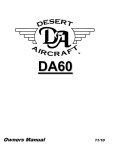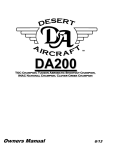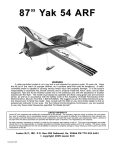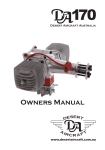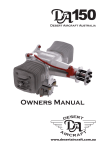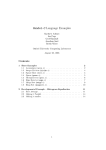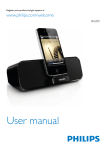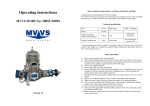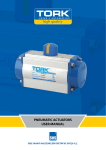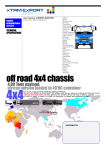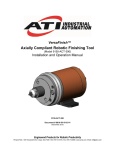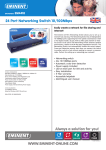Download Owners Manual - Desert Aircraft
Transcript
TM D A 70 Owners Manual 1/14 Safety Instructions READ THIS! WARNING! This motor can cause severe harm to you, and/or others, if misused or if these safety precautions and instructions are not observed. Desert Aircraft is not responsible for any loss, injury, or damage resulting from the miss-use of its products. You alone are responsible for the safe operation of your motor. This motor can stop at any time, for a variety of reasons. Do not fly your plane in such a way that damage or harm will result if the motor stops running. If you cannot fly your plane safely if the motor stops running for any reason, do not fly the plane. Do not operate the motor if you do not want to be completely responsible for any damage or injury incurred or caused during its operation. Read all instructions before operating your motor. If you have any questions about any aspect of operating this motor, do not attempt to start or operate it. Never operate the motor, or fly, alone. When operating the motor, never stand, or allow anyone else to stand, in front of, or to the side of the propeller. Always stand behind the propeller. Keep away from the prop while operating the motor. Do not wear loose clothing near the motor or prop. Do not run the motor near loose material such as dirt, gravel, power cords, ropes, sand, etc. Loose material can be drawn into the turning prop causing injury or damage. Always operate the motor in an open area. Do not operate indoors. This motor can develop tremendous thrust. Make sure the aircraft is properly secured when starting or operating the motor. Inspect motor mount bolts and firewall integrity before operating the motor. Anyone in the immediate area of the motor should use eye protection during operation of the motor. Keep spectators at least 30 feet away when operating the motor. Turn off the motor before making any adjustments. Always use the correct length propeller bolts. Do not use spacers behind the propeller. Spinner cones must not touch the propeller. Thinner props may require using shorter prop bolts, especially if not using a spinner back plate. Make sure your prop bolts do not bottom out in the propeller hub. Check that the propeller bolts are tight before every flight. Always install an ignition kill switch to stop the motor. Adjust the carburetor linkage so that the motor will stop when the carburetor is completely closed. Gasoline is extremely flammable. Be careful of any sparks from electrical contacts such as fuel pumps, battery chargers, etc. Do not allow smoking in the area of your fuel supply or motor. Store fuel in approved containers and in well ventilated areas. Allow the motor to cool before touching or fueling. Always turn the prop a few revolutions after running the motor to discharge the ignition system. The ignition system develops extremely high voltage. Do not touch it during operation. Never use a damaged or repaired prop, or a prop that has struck the ground or any other object. Un-dected damage could turn into disaster when the prop is turning at thousands of RPM. 1 Motor Installation Mount the motor using high grade 1/4" or 6mm dia. bolts with washers and locking nuts on the rear of the firewall. Make sure your firewall is structurally sound. The crankshaft centerline is in the exact center of the rear mounting plate bolt pattern. The throttle arm is pre-tapped for a 2-56 ball link. Make sure the carburetor's idle set screw is removed or set so that the carb can be fully closed by the servo at low trim. Use a high quality servo for the throttle. A poor quality servo or linkage will not provide accurate and repeatable throttle settings. Don't use metal to metal linkages. You can un-hook, but don't remove, the throttle return spring if the motor is not going to be bench run. The spring helps to limit shaft wear due to vibration. Do not try to rotate the carburetor 180 deg. on the mounting block or remove the butterfly shaft assembly. The carburetor should have at least 1” (25mm) of clearance between the carb intake and the bottom of the cowl. If there is less than 1", make an opening in the cowl below the carb at least as large as the carb intake diameter. Since the carburetor must often be adjusted differently with the cowl on as compared to off, we recommend small access holes be made in the cowl for adjusting the needle valves with a long, narrow, screw driver. Sometimes the needles can be reached through the cowl's openings for the exhaust system. A 24 oz. (or larger) fuel tank is recommended. The tank must be vented. The carb has a strong pump, so the tank can be mounted almost anywhere. The fuel line and tank stopper must be gas compatible. Do not use any silicone sealers on the fuel system. Gas can break it down and carry it into the carb. The inner diameter of the fuel tubing should be the same or larger than the carburetor's fuel inlet fitting's inner diameter. 1/8” I.D. is recommended. Make sure all fuel line connections are secure. Small nylon zip ties work well to keep the fuel line on the metal fittings. Make sure the fuel line is secure and not near the exhaust or cylinder fins. While an inline fuel filter can be used, we recommend filtering the gas entering the fuel tank from your field container. Cooling is critical to motor performance and longevity. Allow as much cooling air as possible in through the front inlets of the cowl. Allow an outlet opening approximately 2 1/2 times larger than the intake at the bottom rear of the cowl for the hot air to escape. Air must flow through the cylinder fins, not just inside the cowl, to properly cool the motor. Don't let the air take the easy way out! Make it go through the fins. Round cowls with large frontal openings need ducting to direct the air through the cylinder fins. Any air not directed to the engine is wasted. Air ducts can be made from thin plywood, balsa, fiberglass, or aluminum sheet to guide and force air from the front inlets to and through the cylinder fins. Depending on the location of the exhaust system, and cowl airflow, the carburetor may need some air cooling also. A hot carb or fuel system can make the engine erratic in flight or make the engine hard to restart. Sometimes placing heat shielding material between the exhaust and carburetor can help. Keep components like the ignition system, fuel tank, fuel lines, receivers, etc, shielded from heat generated by canister and tuned pipe exhaust systems. Hot fuel tanks and fuel lines can cause frustrating tuning issues, and over heated electronic components can have intermittent problems or total failures. 2 Ignition System When making electrical connections to the ignition system, use the same gauge wire (or larger) as used on the red and black power leads on the ignition module, all the way to the battery pack. Keep wire length to a minimum. Heavy-duty plugs, as supplied on the ignition, or as used on electric cars and planes, are recommended. Use a high quality switch such as JR’s heavy-duty switch. Standard size R/C receiver switches are not recommended. Make sure the charge current does not reach the ignition module. In other words don’t “charge” the ignition module. Keep ignition components and wiring separated, as much as possible, from your receiver, receiver battery, servos, wiring and switches. Don’t use metal-to-metal linkages to operate the throttle. Always perform a radio range check before flying. Range should be at least 200 Ft. with the plane on the ground and the motor running. If there are “glitches”, DON’T FLY! Check for holes in the braided shielding, loose connections, etc. The ignition can be powered directly by 4 or 5 cell 4.8 or 6 volt NiCd/NiMH batteries, or 6.6 volt A123/LiFe batteries. If using batteries rated at more than 6.6 volts, a 5.5 or 6 volt regulator must be used. Higher voltage will damage the ignition system and will void the warranty. We recommend an 2000 mAh or larger capacity pack. With this size pack, the ignition pack charge should last longer than your receiver pack charge. If a meter test shows 5.0 volts or less at the ignition module, don’t fly, re-charge. When connecting the red pick-up sensor to the ignition module, make sure that the polarity of the wires entering the connectors is correct (Brown to brown, orange to orange) Unlike some ignitions, the Desert Aircraft ignition is designed to spark only when the prop is flipped at a high speed. If the prop is not turned over at "starting" speed, the ignition will not produce a spark. This helps to prevent the motor from firing accidentally. The ignition coils can store energy for a short period of time after shut off. A few firm flips of the prop with the ignition off will expend any energy held in the coils by firing for one revolution. When removing the spark plug caps, PULL STRAIGHT out on the caps. Do not pull on the shielded ignition wires! If caps seem loose and are not making a solid metal to metal contact with the spark plug base, use a small hose clamp around the base of the cap to keep them firmly attached to the base of the plug. To prevent radio interference, the spark plug caps must have the split retainer ring around the base to insure a tight fit. – DON’T FLY WITHOUT THEM! Protect the shielded plug wires from rubbing against fiberglass or sharp edges of wood or metal. Rubber grommets and plastic “spiral wrap” insulation from automotive or electronic supply stores work well. Holes in the braided shielding can emit R/F noise or loose connections (spark plug caps, connectors and switches). Timing is set at the factory and should not need adjustment. Contact Desert Aircraft if you have any questions regarding timing. Only use NGK CM-6 spark plugs. Other plugs may not fit the plug caps firmly. Plug gap is .018” to .020" (.38 to .50 mm) Never operate the ignition without a spark plug in the plug caps! This can permanently damage the ignition coil. 3 Fuel and Oil Mix For the DA70, use Premium pump gas, such as 91 to 93 octane. We recommend purchasing your fuel from “name brand” gas stations. We have seen problems with cheaper gas from some discount type outlets. We recommend filtering your fuel between your fuel container and your plane’s fuel tank. A high flow filter, or clunk/filter, between the tank and motor is also a good idea. Make sure the plane’s tank is well vented and the fuel clunk moves freely. Use of any other fuel or additives such as nitro formulas, aviation gas, white gas, etc., can harm the motor and void the warranty. Do not use silicone sealers on the fuel system. Gas can break it down and carry it into the carb. We recommend a high quality synthetic oil. As for the brand of oil, there are many good ones on the market. Some oils, and their mix ratios, that Desert Aircraft recommends are Red-line Two Stroke Racing Oil (40 to 1) and Motul 800 (50 to 1). These oils can be found at most motorcycle shops. Break-in We do not recommend breaking the engine in on a test stand. The stationary load and lack of air ducting can lead to engine overheating. After a few short runs and any required needle adjustments, we recommend flying the engine. The engine should run well from the beginning and improve as flight hours accumulate. Special break in props are not required. Just don't start with something beyond the recommended sizes. Over loading the engine creates excessive heat. Peak rpm should be over 6,200 during the break-in process. Adjust the needles as needed and give the engine a few easy flights. The needles may need adjustment as the engine settles in and when other things change such as different props, exhaust, weather, and altitude. Recommended Props Always check and tighten prop bolts before each flight! Loose prop bolts allow prop movement, which will shear the bolts. Always use the correct length prop bolts! If a spinner back plate is not used, the prop bolts may be too long and can bottom out in the hub before they fully tighten against the prop washer. The exhaust system, weight of the airplane, field elevation, etc., will have an effect on what prop load will work best for your application. Some recommended props are: Wood: 22x12, 24x9, 24x10, 25x8 Mejzlik Carbon: 24x10, 24x10TH, 26x8 Mejzlik Carbon 3 blade: 21x12, 22x10, 22x12, 23x10 The DA70 has a wide power band. The "normal" peak operating rpm range for break-in is 6,200 to 6,700 rpm, and 6,000 to 6,900 rpm for normal aerobatics after break-in. Smaller diameter props with more pitch, especially 3 blades, can reduce tip speed and noise. Always use a drill guide to drill your props. Always check the balance of your prop. For safety, we recommend painting the tips of your props (front and back) with a bright color, especially on black props. 4 Starting 1. 2. 3. 4. 5. 6. 7. Check that prop bolts are tight and spinner is secure. Make sure the starting area is free of dirt, sand, gravel, or other loose debris Turn on the radio system and check the throttle operation and position. Have someone (with eye protection) firmly hold the plane. Close the choke completely. Open the throttle to approximately 1/4 position. Turn on the ignition. ALWAYS BE PREPARED FOR THE MOTOR TO START ON ANY FLIP OF THE PROP, whether the ignition switch is on or off! 8. Always wear a heavy leather glove when starting the motor. 9. Give the prop a quick, firm, flip counter clockwise. Follow through quickly as you flip the prop so your hand is out of the propeller's path. Repeat until the motor fires or “pops”. 10. Open the choke. 11. Set throttle to idle position. (carb butterfly plate slightly open) 12. Flip the prop again until the motor runs. 13. Let the motor warm up for 15 or 20 seconds before advancing the throttle. Needle Adjustments The needle farthest from the motor is the “High RPM” needle. The needle closest to motor is the “Low RPM” needle. Turning the needles clockwise “leans” the fuel mixture. Turning the needles counter-clockwise “richens” the fuel mixture. Settings will vary with altitude, temperature, humidity, fuel, carb variances, etc. A general starting point is: 1 1/4 open on the Low needle, 1 1/4 open on the High needle. Adjusting either needle (primarily the Low) can have a slight effect on the other. Example: leaning the Low needle can "slightly" lean the high range. Adjust the Low RPM needle until you achieve a smooth idle and a reliable transition to high throttle. Generally if the motor “stutters” or “coughs” in the mid range or when the throttle is advanced, the low end needle is too rich and possibly even the high end needle. If the motor dies quickly, the low end is probably lean. Adjust the High RPM needle to peak rpm. A tachometer is a great help, but remember that the RPM may drop a little bit after every start due to residual heat build up. Don’t lean the mixture any more than necessary. If the rpm steadily drops at full throttle or fades on long vertical maneuvers, the motor is too lean and is over heating. Don't set the needles overly rich to protect the engine. Operating the motor overly rich not only reduces power, it creates other problems such as poor transition, vibration, pre-mature carbon build up, fouled plugs, excessive exhaust residue, sticking rings, and overall rough running. Trouble Shooting Motor won't start Check battery voltage (should be 5.0+ volts when checked under load) and all ignition connections, wiring, and switches (both standard and optical). Wires can break from vibration near connectors. Check and/or swap out regulator if using one Check tank venting, clunk position, and fuel flow. Does fuel move towards the carb when the prop is flipped? If carb isn’t priming, is choke plate closing completely? Is the carb or carb mount loose causing an air leak? Look for fuel seepage. Is throttle set at idle or slightly higher after motor “pops” and choke is opened? (Cont'd) 5 Make sure prop is flipped over with authority. The ignition won’t fire at low speed. If a lot of fuel drips from carb, the motor might be flooded. If so, remove and dry, or replace, the spark plugs. Try starting again without using the choke, then use the choke if required. Other issues Fuel drips continually from carb: Make sure there is no debris in the needle seat. Remove needles and blow air into the holes. RPM won’t go over 3,500 to 4,000: Check that the polarity of the connection between sensor and ignition is correct (not plugged in backwards). Broken prop bolts: In order for bolts to shear, some type of side loading (shear) movement is usually required. If the bolts are tightened correctly, nothing moves and prop bolts will rarely break. It’s a good idea to replace prop bolts routinely. Check prop bolts before each flight! Excessive vibration: Check that low rpm needle setting is not too rich. Check prop and spinner balance. Make sure ignition timing is correct. Pink or purple colored cylinders: These colors indicate engine temperature has been too high. Check that needle settings are not too lean, air flow for cooling is sufficient, oil/gas mixture is correct. Engine starts backwards: Make sure prop is flipped forcefully through the compression stroke. Without enough force, the prop may "bounce" off compression and run backwards. IF ANY PROBLEM PERSISTS, PLEASE CONTACT DESERT AIRCRAFT FIRST! We designed and manufactured your engine and have built, serviced, and analyzed thousands more. We cover your engine’s warranty, not someone at the field or a stranger on the Internet. Please give us the opportunity to help first! Maintenance Being a high performance 2 stroke engine, certain parts can wear quickly. Under normal operation, pistons, piston rings, needle bearings, spark plugs, etc. may need occasional non-warranty replacement to insure peak performance. Screws can come loose! After a few flights check that all screws are secure. Periodically check that all screws are tightened to the correct torque rating. It's recommended to replace, rather than re-use the red aluminum screws. Size Spark plug: CM-6, 10mm Steel prop bolts: M5x 45mm Aluminum crankcase bolts: M5x16mm Aluminum cylinder base bolts: M5x16mm Aluminum carb mount bolts: M5x67mm Torque specifications 90 in. lbs. 65 in. lbs. / wood props, 80 in. lbs. /carbon props. 70 in. lbs. (Don’t re-use. Replace with new) 70 in. lbs. (Don’t re-use. Replace with new) 50 in. lbs.* (Desert Aircraft item) *Caution: Care must be taken to not over tighten the carb mounting bolts. Over tightening can distort and damage the injected molded reed valve parts and rubber gaskets. Use a 4m hex wrench for all M5 cap screws. For spinner mounting, the crankshaft extension is threaded for M5 screws. In this application (steel to steel) the 10-32 SAE screws supplied with most spinners will work fine in the M5 threaded hole. Do not substitute 10-32 screws for any other screws on the engine! (Cont'd) 6 Inspect the engine periodically for any signs of fuel seepage. This can indicate an air leak which can create a lean fuel/air ratio, which in turn can cause erratic running and engine damage. If tightening the appropriate screws does not cure the problem, contact Desert Aircraft. After prolonged use, carbon deposits can build up on top of the piston and on the combustion dome of the cylinder. Great care must be taken when trying to remove these carbon deposits to avoid damaging the parts. Once an attempt to remove carbon has been made, the task must be completed, as any remaining carbon may be loosened and can dislodge while the engine is running. This can damage the engine and/or bridge the spark plug. Manuals may be updated with additional tips and trouble-shooting info from time to time. Please check our web site, www.desertaircraft.com , for current downloadable manuals and updates. Remember! This motor can stop at any time, for a variety of reasons. Do not fly your plane in a way that damage or harm will result if the motor stops running. If you cannot safely fly your plane if the engine stops for any reason, do not fly the plane. Desert Aircraft will not be responsible for damage caused in engine–out situations. DA70 WARRANTY Your DA70 motor and ignition system are covered with a 3 year warranty by Desert Aircraft, starting from the date of purchase. This warranty covers defects in workmanship and materials only. Do not disassemble the motor or ignition system. Disassembly of the motor or ignition system can void the warranty on that item. Any modifications to the motor, or the ignition system, or the use of aftermarket parts, other than those authorized by Desert Aircraft, will void this warranty. This warranty does not cover the following: Shipping expenses to and from Desert Aircraft for warranty service. Damage caused by improper handling, operation, or maintenance. Damage caused by a crash. Damage caused by using improper fuel or additives. Damage incurred during transit to Desert Aircraft. WRAP AND PACK ENGINE CAREFULLY!! NOTE: DESERT AIRCRAFT WILL NOT SHIP OR REPLACE ANY WARRANTY REPLACEMENT ITEMS UNTIL ITEMS IN QUESTION ARE RECEIVED BY DESERT AIRCRAFT AND DEEMED DEFECTIVE. DESERT AIRCRAFT 1815 S. Research Loop Tucson, AZ 85710 USA Ph 520 722 0607 Fax 520 722 5622 Email [email protected] Web www.desertaircraft.com 7 Repair/Return Form (Please make copy) Please fill out and enclose this form when shipping items for service Customer Name_________________________________ Date___________ Address________________________________________________________ City______________________ State______ Zip_________ Country________ Phone #_________________ Cell #__________________ Email _________________________ Items in Box: DA35 Serial #__________ DA50 Serial #__________ DA70 Serial #__________ DA85 Serial #__________ DA100i Serial #________ DA120 Serial #_________ DA170 Serial #_________ DA200 serial #_________ Single Ignition Serial # ________ DA60 Serial #__________ DA100 Serial #_________ DA150 Serial #_________ Other________________ Twin Ignition Serial # ________ (Below items normally not required to repair or test the engine) Prop Bolts? ___________ Prop washer? _________ Muffler(s)? ____________ Muffler screws_____________ Standoffs? ____________ Other Items? __________ REASON FOR ENGINE AND/OR IGNITION RETURN? Crash: Yes____ No____ Other_________________________________________ _______________________________________________________________________ _______________________________________________________________________ _______________________________________________________________________ _______________________________________________________________________ _______________________________________________________________________ _______________________________________________________________________ Prop used? ______________ Gas type? _____________ Oil used? _____________ Exhaust system type? __________________ Has the engine been sent in for service before? _______Why?________________ ______________________________________________________________________ ______________________________________________________________________ DESERT AIRCRAFT 1815 S. Research Loop Tucson, AZ 85710 520 722 0607 [email protected] www.desertaircraft.com









